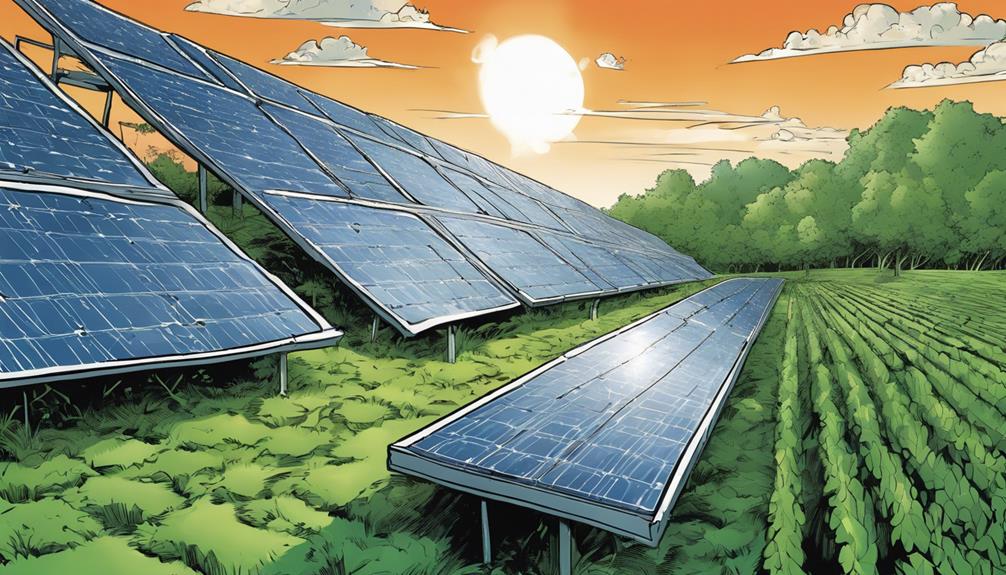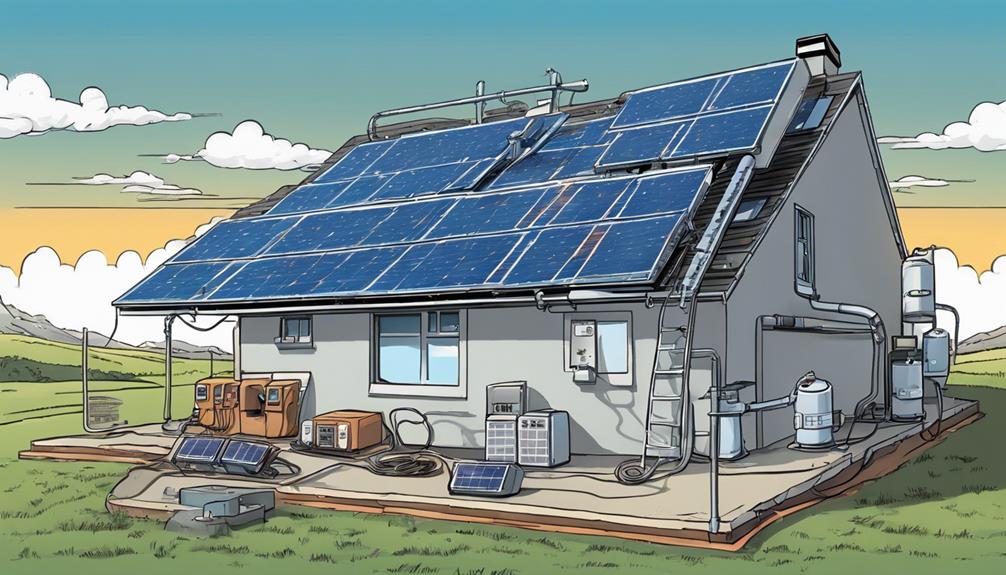When constructing a solar farm, I understand that maximizing energy efficiency is crucial for a dependable and cost-efficient clean energy supply. It all begins with a well-planned construction process that takes into account key factors. First, I choose a site with level land, close proximity to water sources, and minimal shading. Then, I design and position panels to optimize output, taking into consideration tilt, azimuth, and spacing. Regular inspections, real-time monitoring, and performance data analysis guarantee peak performance. I also evaluate environmental impact, incorporate smart grid technology, and enhance energy output and capacity. By following these steps, I can ensure an effective solar farm – and that marks just the start of the journey to harnessing the sun's energy efficiently.
Key Takeaways
- Optimize site selection by considering flat land, proximity to habitats, water resource availability, and sufficient land for optimal size and capacity.
- Design and place solar panels to maximize output, minimizing shading and ensuring efficient panel layout and orientation.
- Implement regular inspections, real-time monitoring, and performance data analysis to ensure peak performance and optimize energy production.
- Minimize environmental impact by assessing proximity to habitats, water usage, land use, and restoration plans, and analyzing effects on local ecosystems.
- Integrate smart grid technology to enable real-time monitoring, efficient communication, and prediction of energy demand to minimize waste and reduce grid strain.
Site Selection and Planning
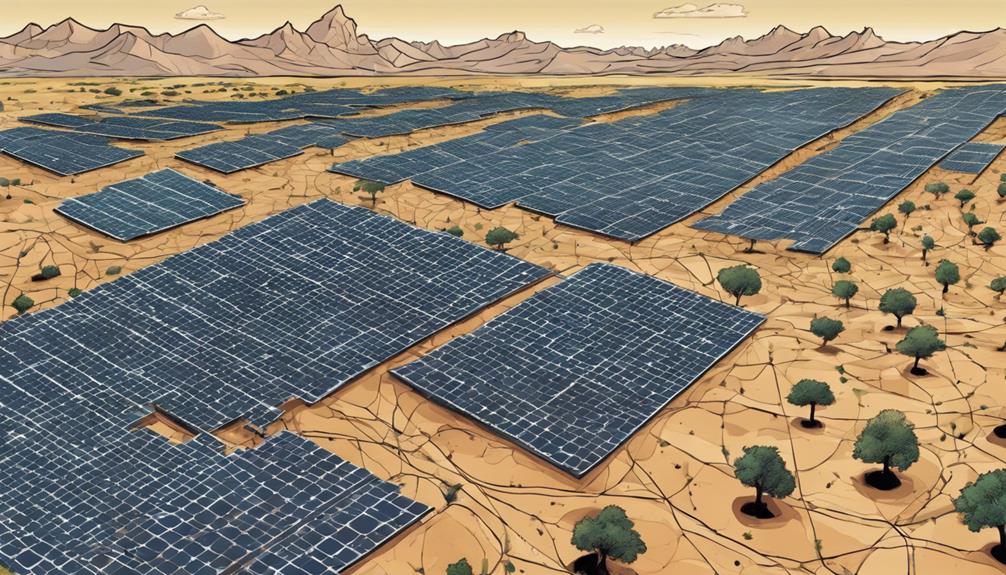
When it comes to solar farm construction, selecting the right site is vital, as it directly impacts the project's energy efficiency, environmental sustainability, and overall cost-effectiveness.
I've learned that flat land is ideal, as it minimizes grading and earthwork needs. Proximity to sensitive habitats and wildlife migration patterns must also be considered to avoid negative environmental impacts. Additionally, I assess water resource availability and potential shading from nearby structures.
Sufficient land is essential for the best size and capacity of the solar farm. By carefully evaluating these factors, I can ensure that the site is suitable for maximum energy production and output.
This careful planning sets the stage for a successful and efficient solar farm project.
Efficient Panel Design and Placement
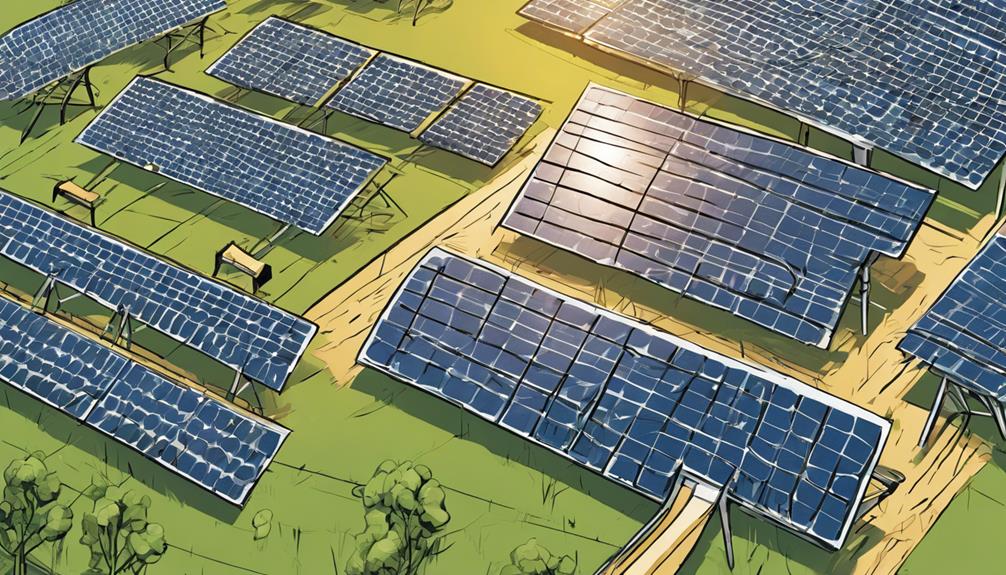
I now focus on enhancing energy production by designing and placing solar panels in a way that maximizes their output, as efficient panel layout and orientation are critical to harnessing the sun's energy effectively.
A well-designed panel layout guarantees that each panel receives the best amount of sunlight, reducing energy losses and increasing overall energy production. I consider factors such as panel tilt, azimuth, and spacing to minimize shading and maximize energy output.
Maintenance and Performance Monitoring

As I explore the world of solar farm construction, I've come to realize that regular maintenance and performance monitoring are essential to guaranteeing that solar panels operate at maximum capacity. Even slight dips in efficiency can have a notable impact on the overall energy output of the solar farm.
To achieve best energy efficiency, I've identified the following key aspects of maintenance and performance monitoring:
- Regular inspections: Routinely inspecting the solar panels and surrounding infrastructure to identify potential issues before they become major problems.
- Real-time monitoring: Using advanced monitoring systems to track the performance of the solar farm in real-time, allowing for swift response to any deviations from optimal performance.
- Data analysis: Examining performance data to identify trends and areas for improvement, enabling data-driven decisions to optimize energy output.
- Scheduled maintenance: Planning regular maintenance tasks, such as cleaning and repairs, to guarantee that the solar farm operates at peak performance.
Environmental Impact Assessment
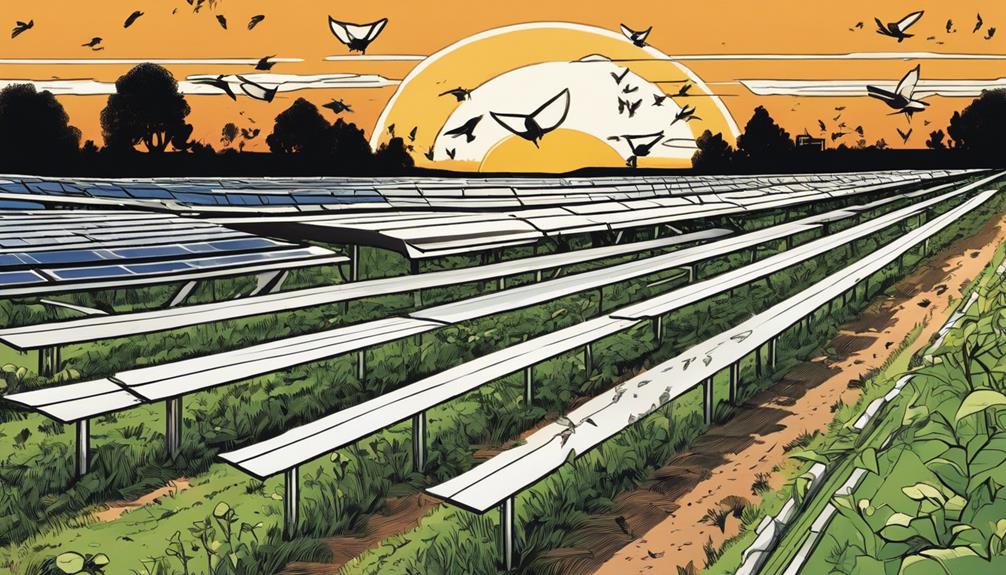
During the solar farm construction process, conducting a thorough environmental impact evaluation is essential to identify and mitigate potential ecological consequences. As a responsible developer, I prioritize analyzing the project's effects on local ecosystems, wildlife habitats, and water resources. This involves evaluating the site's topography, soil composition, and natural habitats to minimize disturbances.
| Environmental Factor | Evaluation Criteria |
|---|---|
| Proximity to sensitive habitats | Distance from protected areas, wildlife migration patterns |
| Water resource availability | Water usage, potential impacts on local aquatic ecosystems |
| Land use and grading | Soil erosion, land degradation, and restoration plans |
Smart Grid Technology Integration
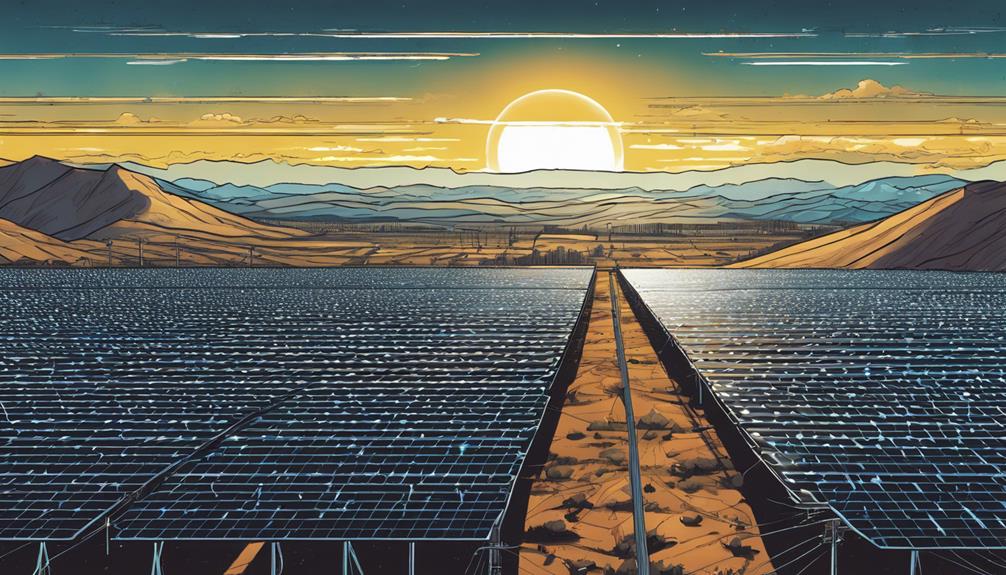
Integrating smart grid technology into solar farm construction enables real-time monitoring and control of energy distribution, maximizing efficiency and reducing power losses. This innovative approach allows for seamless communication between the solar farm and the grid, ensuring that energy is distributed efficiently.
By leveraging advanced technologies like IoT and AI, smart grids can predict energy demand and adjust supply accordingly, minimizing waste and reducing strain on the grid.
- Real-time monitoring of energy output and grid demand
- Automated control systems for efficient energy distribution
- Advanced weather forecasting for predictive energy management
- Enhanced cybersecurity measures to protect the grid from potential threats
Energy Output and Capacity Optimization

We frequently optimize energy output and capacity by strategically arranging solar panels to maximize exposure to direct sunlight and minimize shading from surrounding structures. This is pivotal in ensuring our solar farm operates at its peak performance.
I make sure to assess the site's topography and environmental factors to determine the ideal panel arrangement. By doing so, we can increase energy production and reduce energy losses.
Additionally, regular maintenance and monitoring of the panels are essential to identify any potential issues that might affect energy output. By optimizing energy output and capacity, we can guarantee a reliable and efficient supply of clean energy to the grid.
Land Use and Resource Management
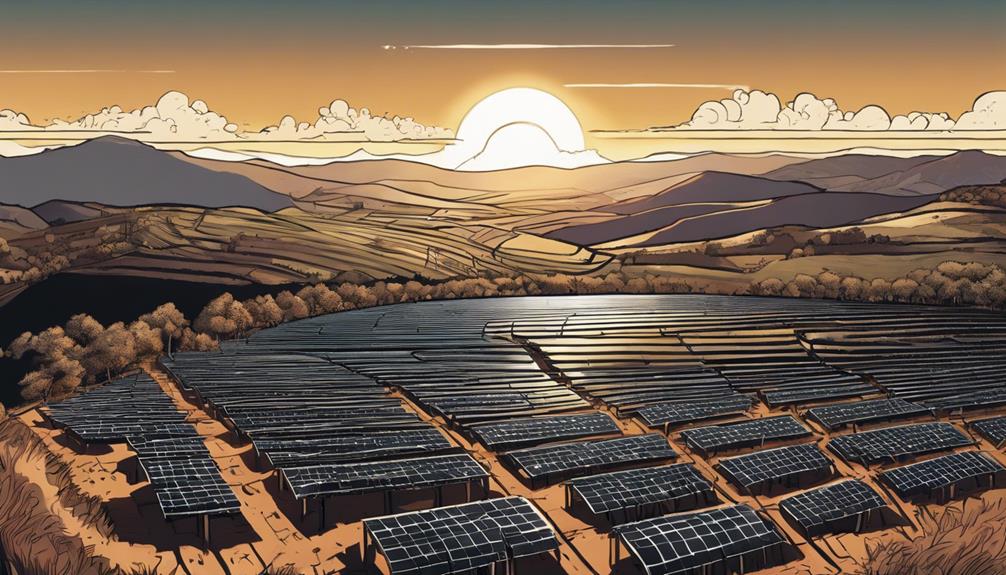
When choosing a site for solar farm construction, I consider the land's natural features and available resources to guarantee maximum energy generation while minimizing environmental impacts. Flat land, for example, reduces the need for extensive grading and earthwork, which in turn lowers construction costs.
It's crucial to evaluate the land's susceptibility to shading from nearby structures and assess water resource availability.
To ensure efficient land use and resource management, I take into account the following factors:
- Closeness to delicate habitats and wildlife migration routes
- Impact on the ecosystem
- Availability of water resources and the potential for shading from nearby structures
- Level terrain to reduce grading and earthwork requirements
Frequently Asked Questions
How Does Solar Farm Construction Impact Local Wildlife Habitats and Ecosystems?
When building solar farms, I evaluate the environmental impact on local wildlife habitats and ecosystems, ensuring minimal disruption to natural habitats and migration patterns by analyzing and mitigating potential effects.
Can Solar Farms Be Built on Contaminated or Polluted Land Sites?
"As I walk through a polluted industrial site, I wonder, can solar farms thrive here? Coincidentally, yes – contaminated lands can be repurposed for solar farms, revitalizing the area while generating clean energy."
What Is the Average Lifespan of a Commercial-Scale Solar Panel System?
I've learned that the average lifespan of a commercial-scale solar panel system is around 30 years, with some systems lasting up to 40 years or more, depending on quality and maintenance.
How Do Weather Patterns Affect Solar Energy Output and Efficiency?
'When it rains, it pours, and that's exactly what happens to solar energy output on cloudy days. Weather patterns impact efficiency, with cloud cover reducing output by up to 90%, while extreme temperatures also take a toll.'
Are There Any Incentives or Tax Credits for Building Solar Farms in Rural Areas?
"Yes, there are incentives and tax credits for building solar farms in rural areas. I've seen programs like the USDA's Rural Energy for America Program offering grants and loan guarantees to rural solar projects."
How Can Innovative Incentives Help Optimize Energy Efficiency in Solar Farm Construction?
Innovative solar farm incentives can play a crucial role in optimizing energy efficiency during the construction phase. By offering financial rewards and benefits for utilizing eco-friendly construction practices and energy-efficient technologies, developers are incentivized to prioritize sustainability in solar farm projects. This can ultimately lead to a more sustainable and environmentally friendly solar energy infrastructure.
Conclusion
As I reflect on the intricate dance of solar farm construction, I'm reminded that every detail, every decision, and every calculation is a brushstroke on the canvas of a sustainable future.
By carefully balancing efficiency, environmental stewardship, and innovation, we can create vibrant, thriving solar farms that not only harness the sun's energy but also paint a brighter, more hopeful tomorrow.
